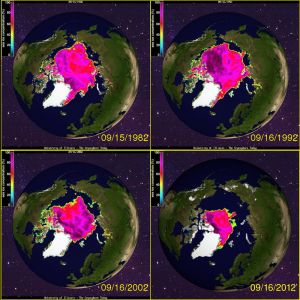Current Developments
 Click to enlarge - The Arctic Sea Ice Extent, comparison between the last few years and the 1979-2000 Avarage. (Graph from NSIDC)The summer of 2012 saw the record low ice extent in the Arctic ocean, since the beginning of satellite data record ranging back to 1979 as well as other recorded data ranging back to the 50's.
Click to enlarge - The Arctic Sea Ice Extent, comparison between the last few years and the 1979-2000 Avarage. (Graph from NSIDC)The summer of 2012 saw the record low ice extent in the Arctic ocean, since the beginning of satellite data record ranging back to 1979 as well as other recorded data ranging back to the 50's.
The previous record low occurred in 2007.
NASA study finds that perennial sea ice in the Arctic is melting faster than previously thought -- at a rate of 9 percent per decade. If these melting rates continue for a few more decades, the perennial sea ice will likely disappear entirely within this century, due to rising temperatures and interactions between ice, ocean and the atmosphere that accelerate the melting process.
On September 16, 2012 sea ice extent dropped to 3.41 million square kilometers, 760,000 square kilometers below the previous record minimum extent in the satellite record, which occurred on September 18, 2007.
That means there less ice in the Arctic which would cover all of Norway, Denmark and Finland combined.
 Sea ice extent on the 16th of September 1982, 1992, 2002 and 2012. Click to enlarge. (Photo: Cryosphere Today).week in September.
Sea ice extent on the 16th of September 1982, 1992, 2002 and 2012. Click to enlarge. (Photo: Cryosphere Today).week in September.In 2012, the rate of ice loss for August was 91,700 square kilometers per day, the fastest observed for the month of August over the period of satellite observations. In August 2007, ice was lost at a rate of 66,000 square kilometers per day, and in 2008, the year with the previous highest August ice loss, the rate was 80,600 square kilometers per day. This shows that the melt is faster then ever.
In a 2008 article titled, Recent radical shifts of atmospheric circulations and rapid changes in Arctic climate system Zhang et al. show that the extreme loss of Arctic sea ice since 2001 has been accompanied by a radical shift of the Arctic atmospheric circulation patterns, into a new mode they call the Arctic Rapid change Pattern. The new atmospheric circulation pattern has also been recognized by other researchers, who refer to it as the Arctic Dipole (Richter-Menge et al., 2009).
Source: NSIDC Dr Jeff Masters- Weather Underground NSIDC2 NASA








